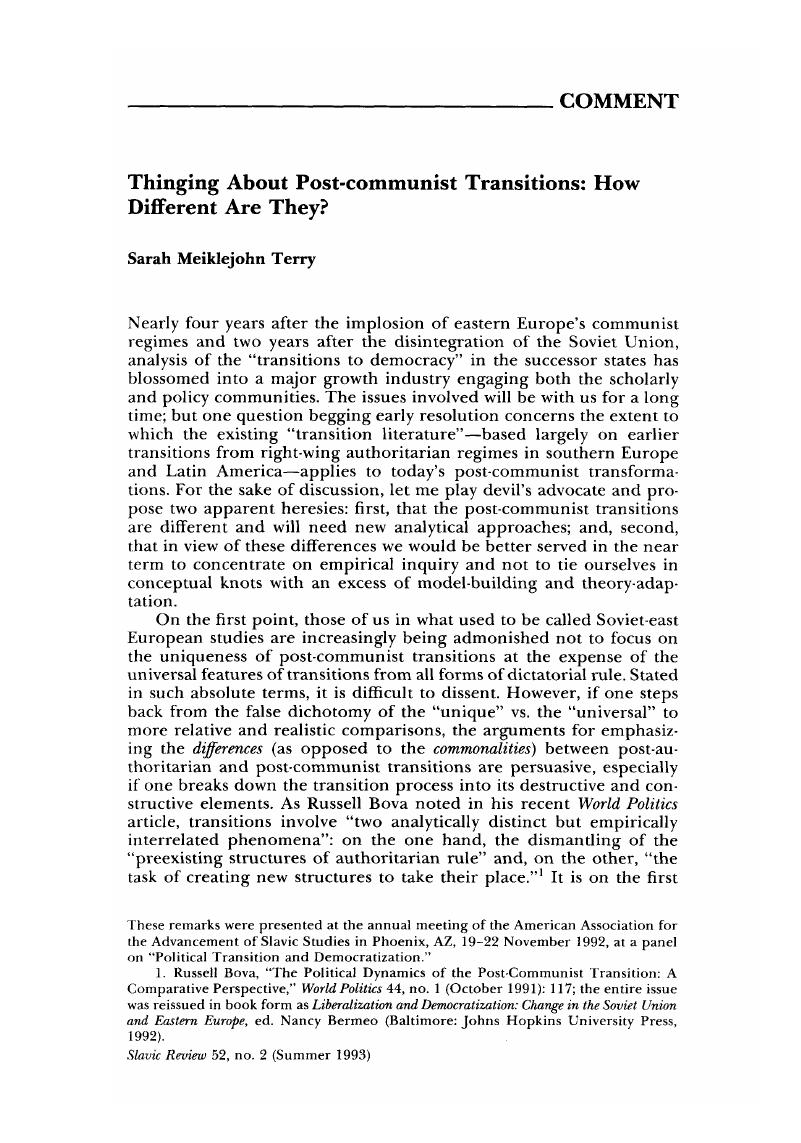Crossref Citations
This article has been cited by the following publications. This list is generated based on data provided by
Crossref.
Schmitter, Philippe C.
and
Karl, Terry Lynn
1994.
The Conceptual Travels of Transitologists and Consolidologists: How Far to the East Should They Attempt to Go?.
Slavic Review,
Vol. 53,
Issue. 1,
p.
173.
Baylis, Thomas A.
1994.
Plus ça change? Transformation and continuity among east European elites.
Communist and Post-Communist Studies,
Vol. 27,
Issue. 3,
p.
315.
CRAWFORD, BEVERLY
and
LIJPHART, AREND
1995.
Explaining Political and Economic Change in Post-Communist Eastern Europe.
Comparative Political Studies,
Vol. 28,
Issue. 2,
p.
171.
Bunce, Valerie
1995.
Should Transitologists Be Grounded?.
Slavic Review,
Vol. 54,
Issue. 1,
p.
111.
Welsh, Helga A.
1996.
Dealing with the communist past: Central and East European experiences after 1990.
Europe-Asia Studies,
Vol. 48,
Issue. 3,
p.
413.
Nichols, Thomas M.
1996.
Russian democracy and social capital.
Social Science Information,
Vol. 35,
Issue. 4,
p.
629.
Munck, Gerardo L.
1996.
Disaggregating Political Regime: Conceptual Issues in the Study of Democratization.
SSRN Electronic Journal,
Rivera, Sharon Werning
1996.
Historical Cleavages or Transition Mode?.
Party Politics,
Vol. 2,
Issue. 2,
p.
177.
O'Loughlin, John
Shin, Michael
and
Talbot, Paul
1996.
Political Geographies and Cleavages in the Russian Parliamentary Elections.
Post-Soviet Geography and Economics,
Vol. 37,
Issue. 6,
p.
355.
Intriligator, Michael D.
1996.
Reform of the Russian economy: the role of institutions.
International Journal of Social Economics,
Vol. 23,
Issue. 10/11,
p.
58.
Markwick, Roger D.
1996.
A Discipline in transition?: From sovietology to ‘Transitology’.
Journal of Communist Studies and Transition Politics,
Vol. 12,
Issue. 3,
p.
255.
Sakwa, Richard
1996.
Russian Studies: The Fractured Mirror.
Politics,
Vol. 16,
Issue. 3,
p.
175.
Hahn, Gordon M.
1996.
Russia’s Polarized Political Spectrum.
Problems of Post-Communism,
Vol. 43,
Issue. 3,
p.
11.
Fleron, Frederic J.
1996.
The logic of inquiry in post-Soviet studies: Art or science?.
Communist and Post-Communist Studies,
Vol. 29,
Issue. 3,
p.
245.
Seroka, Jim
1996.
Democratization in the successor states to socialist Yugoslavia.
The European Legacy,
Vol. 1,
Issue. 2,
p.
459.
Metcalf, Lee Kendall
1997.
Institutional Choice and Democratic Consolidation: The Experience of the Russian Successor States, 1918-19391.
Communist and Post-Communist Studies,
Vol. 30,
Issue. 3,
p.
307.
Lewis, Paul G.
1997.
Theories of democratization and patterns of regime change in Eastern Europe.
Journal of Communist Studies and Transition Politics,
Vol. 13,
Issue. 1,
p.
4.
Munck, Gerardo L.
1997.
Bringing Postcommunist Societies into Democratization Studies.
Slavic Review,
Vol. 56,
Issue. 3,
p.
542.
Fish, M. Steven
1998.
Democratization's Requisites: The Postcommunist Experience.
Post-Soviet Affairs,
Vol. 14,
Issue. 3,
p.
212.
Miller, William L.
White, Stephen
and
Heywood, Paul
1998.
Values and Political Change in Postcommunist Europe.
p.
48.



